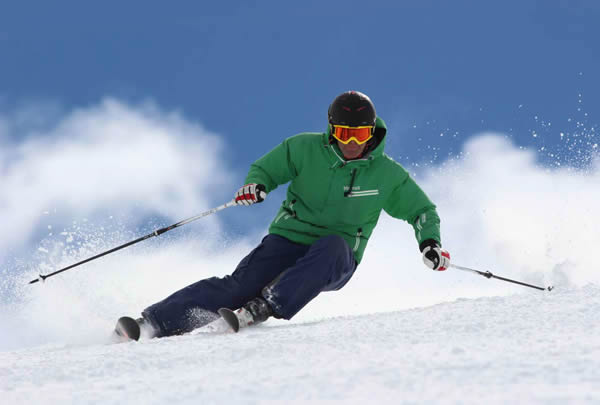ShapeShifter
This is not a lesson per se, but rather a drill through which to experience the feel of true carving. The sad truth is that too many skiers imagine they are carving, but, in fact, are not.
Park and Ride
First, if you are not completely confident of your ability to perform these drills safely and in accordance with the Skiers’ Safety Code, please do not attempt them. If your equipment is not perfectly set up and adjusted, please do not proceed until everything has been checked off by certified binding and boot technicians.
Skis that are out of tune, or that are tuned to other than factory specifications, will render this exercise difficult and dangerous. Boots that are ill fit or misaligned will render the exercise pointless; it won’t work.
Terrain is critical. This exercise should be performed only on smooth, gentle terrain with little or, better, no traffic. Green terrain is best, moderate blue will suffice. Be aware that speed builds rapidly in the exercise and safety is our primary concern.
We call this Park and Ride because it is not dynamic skiing. The goal is to do as little as possible, while letting the skis do the work.
During the exercise, what you don’t do is as important—actually, even more important—as what you do do. Here are the don’ts and, as you shall discover, this is hard part.
As the exercise progresses, do not proactively extend and retract, do not make a conscious weight transfer from one ski to the other. Don’t fight these things should they naturally occur, but do not force anything, either. Just let things happen. Forget about pole plants or touches; just hold your poles comfortably with hands above the waist and slightly more than shoulder-width apart.
Phase I: Knee Rolling
Start straight down the fall line. As speed builds, simply roll both knees in the direction you wish to go. Roll to the right to go right; roll to the left to turn left.
At first, roll knees in one direction and keep rolling them until you come to a complete stop. Above all, do nothing else. Do not steer the ski. Just let the knee-rolling build the turn all the way around until you stop.
Repeat in the other direction. Do this exercise until you can etch a clean set of tracks, with no signs of skidding, in both directions. This may take a few try’s and it may require real concentration on not steering, but it is important to remove all steering at this stage. Let the skis do ALL of the work and stick to it until you can leave clean tracks every time.
How can you tell? Just look!
Skidded tracks look like this:
Clean tracks look like this:
Phase II: Linked knee-rolling turns
At this stage, link some arcs. Start down the hill as before, and roll both knees to one side or the other, as before, but this time, do not go all the way to a stop, but roll knees first to one side and then back to the other.
Practice this until you can link a half-dozen turns in a seamless row.
The track should look like this: 
Phase III: One knee only
Now repeat, making linked turns. Remember, you are not pro-actively forcing weight transfers, nor are you resisting transfer that may be happening automatically and you are still not worried about pole plants or anything except rolling into the new turn…
The difference this time is that you are going to roll only the knee that is on the side to which you wish to turn. In other words, roll the right knee to create a right turn; roll the left knee to turn left.
Don’t worry about the other knee; just let if follow along on its own. You won’t split!
Phase IV: Down to the snow
To dial everything in, repeat the single-knee rolling phase, but concentrate on rolling the ankle—roll left ankle to go left and when you want to turn to the right, roll the right ankle. No up-unweighting. No down-unweighting. No Steering. No forced weight transfer. Just ski tipping controlled by the inside foot.
The effect is the same, but focus is on the ankle and foot.
As a bonus, this drill is an ideal way to liven up otherwise boring run-outs, catwalks, roads and skills.
That’s it; you should be feeling exactly what high-edge-angle carving turns feels like and you will increasingly notice how easy it is to change direction simply by tipping the skis and letting deep side cuts and the reverse-cambered (bent) ski create the arc.
Of course, there is a lot more to high performance technical skiing. We can help . . .




